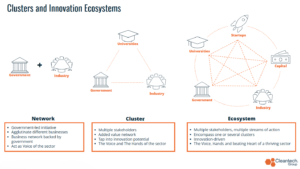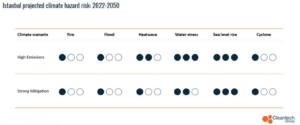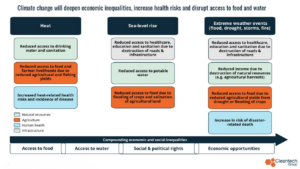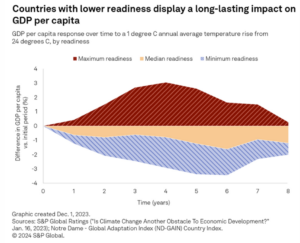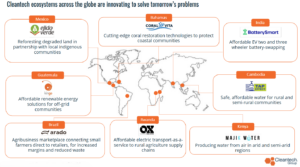Global South Ecosystems are Producing Breakthrough Innovation to Solve Local Climate Needs
Countries in many parts of the world are already experiencing the effects of climate change, and Global South populations are particularly vulnerable. According to UN Trade and Development (UNCTAD), the Global South broadly comprises Africa, Latin America and the Caribbean, Asia excluding Israel, Japan, and South Korea, and Oceania excluding Australia and New Zealand.
(click to enlarge)
Heat waves pose risks to human health and food supply chains, and housing and infrastructure are threatened by droughts, flooding, and storms. These effects are forecast to increase over the coming years. Effective cleantech innovation ecosystems produce and scale the technologies and solutions we need to slow climate change and combat the effects on vulnerable populations globally, bringing economic benefits in the process. Emerging cleantech ecosystems in low- and middle-income countries (LIMCs) globally are producing innovation to serve unmet needs of Global South markets.
Mitigation is Global, Adaptation is Local
Cleantech Group modelled the effects of climate change on eight low- and middle-income countries across four continents across different climate scenarios. In the strong mitigation scenario, the countries faced lower risk of climate hazards. Türkiye was one of the countries. The chart below shows how Istanbul’s risk of heatwaves increases from low to medium in the high emissions scenario, and water stress increases from medium to high.
Adaptation technologies are becoming increasingly necessary however mitigation is still essential. The countries experiencing the worst effects of climate change are not always the biggest emitters, therefore continued mitigation efforts depend on global collaboration.
(click to enlarge)
Climate hazards impact multiple sectors, including risks to human habitat, health, energy, water and food supply chains. Australia’s agricultural sector is grappling with adverse effects on crops from both flooding and drought, depending on the season. Heatwaves have been linked to higher instances of heart attacks, as well as heat-related illnesses such as heatstroke. Outcomes like loss of infrastructure will reduce access to healthcare and sanitation, and crop failure leads to loss of income for farmers. Around the world, electricity grids are at risk from extreme weather events including hurricanes, wildfires and heatwaves.
(click to enlarge)
Across industries, innovators are developing solutions to respond to these challenges.
- Netherlands-based innovator Desolenator has developed a decentralized, solar-powered water desalination system, contributing to drought resilience.
- German startup Dryad is working on an early warning system for forest fires.
- Singaporean Amperesand makes transformers which minimize the impact of extreme weather on electricity grids.
Adopting climate readiness solutions such as these will lead to long-term GDP improvements, powered by avoided losses.
(click to enlarge)
Building a Start-up Solves One Problem: Building an Ecosystem Solves Many Problems
Deploying climate adaptation and resilience solutions helps avoid losses and associated negative GDP impact. Producing, scaling, and exporting those solutions leads to economic growth as well as positive climate impact. Place-based cleantech ecosystems produce and scale a steady stream of start-ups who work to mitigate or tackle the effects of climate change. Cleantech ecosystems and clusters may grow out of established innovation centers, or legacy industries which need to decarbonize, or around city and regional challenges, including climate change effects.
Ecosystems are shaped by strategic priorities and local resources. For example, the South African government has identified an opportunity to develop ex-coal mining areas into cleantech innovation hubs; in the face of increasing water stress, Morocco is directing resources into supporting home-grown water technologies. Spain is building on its existing automotive industry to drive the largest electromobility cluster in Southern Europe.
Climate change effects are moving fast up the list of strategic priorities, with countries from India to Chile innovating their way out of food security risks.
- EF Polymer, founded in Rajasthan, produces a polymer which helps crops to retain water, reducing irrigation needs and soil degradation.
- PolyNatural, from Chile, reduces food waste through a natural food coating which extends shelf life.
Innovations such as these, which have applications in many countries, have the potential to scale globally, amplifying climate and social impact as well as economic growth.
Effective cleantech ecosystems and clusters provide the connective tissue for systemic innovation, turning individual successes into a steady stream of innovation, and supporting that innovation to market through investment, business support, and connection to customers and global networks. This forms a “virtuous circle” of positive economic growth, resulting in increased investment and more jobs. Research by the European Commission found that start-ups located within clusters (local, sector-thematic ecosystems) grow 20% faster than the market average.
This is important because local ecosystems produce innovation which is tailored to local needs and constraints. These may be low-cost versions of solutions which have been successful in other geographies, but they may also be customized in response to local market needs.
- Kenyan innovator Roam has developed EV two-wheelers which are sturdier than their Chinese counterparts, because local entrepreneurs need them to shift heavy loads.
Powered by innovations like this one, Africa’s electric two and three-wheeler market is growing rapidly.
(click to enlarge)
Around the globe, mission-driven entrepreneurs are producing exciting innovations to solve tomorrow’s problems. Cleantech ecosystems catalyze innovation at speed and scale. Intentionally strengthening emerging cleantech ecosystems to build on their unique strengths and opportunities can create a ripple effect and rapidly increase the amount of innovation they bring to market, with remarkable climate, social, and economic rewards.
Industry Groups
We research these industry groups and their cross-cutting underlying enabling technologies with a focus on sustainable innovation:
Technologies and services that make the production of food more efficient and effective
Read the Latest Blogs in Agriculture & Food
See the Innovators Leading the Way in Agriculture & Food:
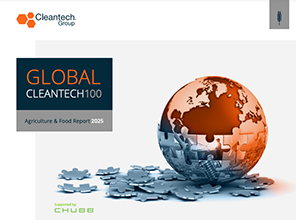
“There’s a funding winter in agri-food. But the future looks promising as investors connect the dots between biotech, automation, and climate adaptation…”
Jack Ellis, Senior Associate
Technologies, services and business models that accelerate the transition to renewable energy and optimize existing processes.
Read the Latest Blogs in Energy & Power
See the Innovators Leading the Way in Energy & Power:

“Macro uncertainty weighs on venture investments, but growing energy demands from data centers have created opportunities for early stage technologies including nuclear solutions which saw significant growth this year.”
Selene Law, Senior Associate & Zainab Gilani, Associate
Innovations which enable the efficient production of basic materials such steel, cement, and chemicals, or advanced materials used in other cleantech sectors
Read the Latest Blogs in Materials & Chemicals
See the Innovators Leading the Way in Materials & Chemicals:

“The overall trend in the Materials & Chemicals industry group reflects positive upward growth, despite some sectors experiencing reduced funding this year, including advanced energy materials and specialty chemicals.”
Buff Lopez, Associate
Technologies and services to protect and restore natural environments, sustainably source materials, prevent waste, improve the circularity of materials, adapt to climate change, and assess corporate environmental impact, carbon, and offset markets
Read the Latest Blogs in Resources & Environmental Management
See the Innovators Leading the Way in Resources & Environmental Management

“In 2024, the landscape for water technology for Resources & Environmental Management looked decidedly different from years past as the Cleantech Group taxonomy has since been split and the new focus of Resources and Environmental Management is exclusively on potable water, digital water technologies, and purification solutions.”
Alex Crutchfield, Associate
Vehicles, technologies and services that move people and goods with zero or low emissions, or in a more resource-efficient way
Read the Latest Blogs in Transportation & Logistics
See the Innovators Leading the Way in Transportation & Logistics:

“The Cleantech Group taxonomy has become more discerning with micromobility innovators, excluding innovators such as ridesharing or leasing companies without clear IP either in vehicle components, design, or fleet management solutions.”
Nicole Cerulli, Associate
Technologies to manage waste in an environmentally sound manor, compared to traditional methods
Read the Latest Blogs in Waste & Recycling
See the Innovators Leading the Way in Waste & Recycling
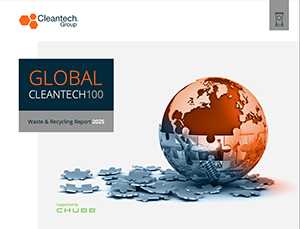
“Plastic recycling had a bounce-back year in many ways. After a 75% decline in venture investment from 2022 to 2023, new innovations in advanced recycling technologies (solvent dissolution, depolymerization, and pyrolysis) have improved recycling efficiency and won back investors’ interest.”
Parker Bovée, Associate
